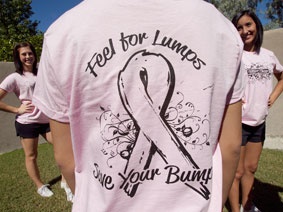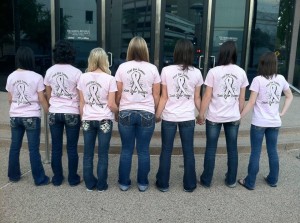School bans Breast Cancer Awareness T-shirts

What does the law say about wearing slogans to school?
We have seen a number of news stories about students in trouble over pins, buttons, wristbands and T-shirts with slogans on them. Some public schools have adopted uniforms that all students are required to wear. As long as the code is applied equally to all students, it will pass a constitutional challenge. Other schools have written dress codes listing what’s allowed and what’s prohibited on campus. Occasionally, a student will wear an “I (heart) Boobies” bracelet or one proclaiming support of gay rights or other popular causes. This is when a decision must be made between a student’s right to free expression and the school’s interest in keeping a safe and educational environment on campus.
In October, 2011, in observance of Breast Cancer Awareness Month, a high school cheer team created a pink T-shirt with the slogan “Feel for Lumps, Save Your Bumps” on the back. The front of the shirt said “Gilbert Cheer” representing Gilbert High School in Arizona. The team planned to wear the shirts at football home games and collect donations from spectators for the Susan G. Komen for the Cure Foundation.
The administration told the girls they could wear plain pink shirts with no slogans. The girls wanted to match the football players who were sporting pink tape, gloves, shoelaces and wristbands during the month of October. Rather than risking suspension, the girls complied while some of their parents wore the T-shirts in the stands during the game on October 14, 2011.
Varsity cheerleader Ashlee Burnau, a 16 year old junior, said she thinks the school is “blowing this out of proportion.” “All we want to do is support the cause and raise money for breast-cancer research.” Stay tuned to AsktheJudge.info for a podcast and/or Skype interview with Ashlee on Wednesday, October 19, 2011.
School dress codes have been challenged many times. Cases are generally resolved at the school district level. Occasionally, however, one will make its way through the courts. A legal challenge can take years to settle and there’s no guaranty that the student will win. Federal and state courts hesitate to get involved with micro-managing school districts. “The education of the nation’s youth is primarily the responsibility of parents, teachers, and state and local officials, and not of federal judges.”(1)
Consequently, court rulings have supported both sides of the issue. Consider the following quotes from decisions of the U.S. Supreme Court (USSC) and a few lower courts. How would you apply the reasoning expressed here to Gilbert High School’s T-shirt challenge? If this case ends up in court, what will be the final decision?
“Students in school as well as out of school are ‘persons’ under our constitution.”(2)
“The schoolroom is the first opportunity most citizens have to experience the power of government–the values they learn there, they take with them in life.”
“Without first establishing discipline and maintaining order, teachers cannot begin to educate their students.”(3)
“Undifferentiated fear or apprehension of disturbance is not enough to overcome the right to freedom of expression.”(4)
“If there is a bedrock principle underlying the First Amendment, it is that the government may not prohibit the expression of an idea simply because society finds the idea itself offensive or disagreeable.” (5)
“The classroom prepares children for citizenship, and the proper exercise of the First Amendment is a hallmark of citizenship in our country.” (6)
“Not every defiant act by a high school student is constitutionally protected speech.” (7)
“A subject should never be excluded from the classroom merely because it is controversial.” (8)
“A school must be able to set high standards for student speech.” Schools may censor expression that is “poorly written, biased or prejudiced, vulgar or profane, or unsuitable for immature audiences.” (9)
 In a related story, the girls basketball team at Burke High School in Nebraska decided to raise awareness and money for the Make-A-Wish Foundation. They wore light pink uniforms at a home-game on February 6, 2012. Their plan was to auction the uniforms after the game and donate the proceeds to Make-A-Wish. They were leading their opponent at half-time. The opposing coach brought to the officials’ attention that the Burke Bulldogs weren’t in white as state rules required of a home-team. Consequently, they were given a technical foul giving the other team two free throws. Burke lost the game 62 to 47.
In a related story, the girls basketball team at Burke High School in Nebraska decided to raise awareness and money for the Make-A-Wish Foundation. They wore light pink uniforms at a home-game on February 6, 2012. Their plan was to auction the uniforms after the game and donate the proceeds to Make-A-Wish. They were leading their opponent at half-time. The opposing coach brought to the officials’ attention that the Burke Bulldogs weren’t in white as state rules required of a home-team. Consequently, they were given a technical foul giving the other team two free throws. Burke lost the game 62 to 47.
(1) Hazelwood v. Kuhlmeier (USSC 1988)
(2) Tinker v. Des Moines Independent Community School District (USSC 1969)
(3) both quotes from New Jersey v. T.L.O. (USSC 1985)
(4) Tinker case above
(5) Texas v. Johnson (USSC 1989)
(6) Chandler v. McMinnville School District (1992)
(7) Bivens v. Albuquerque Public Schools (1995)
(8) Tinker case above
(9) Hazelwood case above




Adolescents can be very immature. While the bracelets and t-shirts are meant to show support for a cause, in the school environment, naturally the students will have a tendency to make inappropriate remarks.